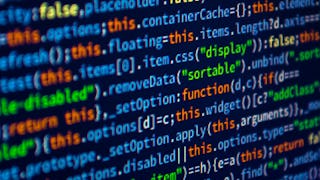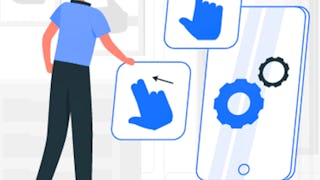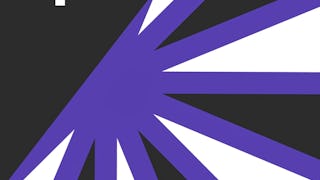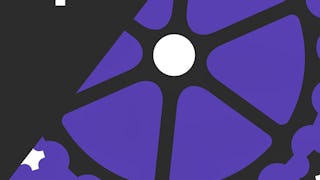If you want to take your website to the next level, the ability to incorporate interactivity is a must. But adding some of these types of capabilities requires a stronger programming language than HTML5 or CSS3, and JavaScript can provide just what you need. With just a basic understanding of the language, you can create a page that will react to common events such as page loads, mouse clicks & movements, and even keyboard input.

Enjoy unlimited growth with a year of Coursera Plus for $199 (regularly $399). Save now.

Interactivity with JavaScript
This course is part of Web Design for Everybody: Basics of Web Development & Coding Specialization


Instructors: Colleen van Lent, Ph.D.
226,602 already enrolled
Included with
(7,361 reviews)
What you'll learn
Understand how JavaScript is used to react to user events.
Write your own JavaScript code to let a person interact with your page.
Discuss how JavaScript can introduce accessibility issues.
Skills you'll gain
Details to know

Add to your LinkedIn profile
3 assignments
See how employees at top companies are mastering in-demand skills

Build your subject-matter expertise
- Learn new concepts from industry experts
- Gain a foundational understanding of a subject or tool
- Develop job-relevant skills with hands-on projects
- Earn a shareable career certificate

There are 4 modules in this course
If you haven't use a traditional programming language before, this first week is key. Before we begin with the how, we will talk about the why, mainly why we want to use JavaScript. The main reason is that it is very easy for JavaScript to work with the DOM. And easy is always a great way to start. Speaking of starting out, it is also always more fun when our code actually does something we can see, so we will jump quickly into different ways we can generate output. It won't be flashy yet, but it will be a great way to get your feet wet with traditional programming. After that we go back to the basics of how a computer uses data. We begin with variables, expressions, and operators.
What's included
7 videos9 readings1 assignment1 discussion prompt
If you have written HTML code in the past, hopefully you have fallen into the great habit of validating your code -- making sure that you close all of your open tags. There are other rules that you may or may not have been following as well, for instance the importance of using each id attribute only once per page. This is called writing "clean" code. The reasoning and importance of following these rules becomes clear as we begin to manipulate the different components of your webpage based on the the actions of the person interacting with your page. In particular you will learn about the JavaScript Mouse Events and Touch Events. This week's materials will end with a photo gallery example that you can create along with me.
What's included
7 videos7 readings1 assignment1 peer review1 app item
This week we will delve into more complex programming concepts: arrays and looping. Arrays allow you to represent groups of related information. Looping provides efficiency and flexibility to your programs. Using both we will expand upon the photo gallery example.
What's included
2 videos5 readings1 assignment
This week is all about putting concepts together to do "cool" things. And we even stop for a second to talk about the the trade-off between cool things and accessibility. The final project this week will be a new version of your coding project in Week 2. You will make an interactive photo gallery from your own images and will add the functionality of keyboard accessibility to it.
What's included
5 videos6 readings1 peer review1 app item
Earn a career certificate
Add this credential to your LinkedIn profile, resume, or CV. Share it on social media and in your performance review.
Instructors

Offered by
Explore more from Mobile and Web Development
 Status: Free Trial
Status: Free TrialUniversity of California, Davis
 Status: Free Trial
Status: Free Trial Status: Free Trial
Status: Free Trial
Why people choose Coursera for their career




Learner reviews
7,361 reviews
- 5 stars
75.70%
- 4 stars
18.91%
- 3 stars
4.17%
- 2 stars
0.76%
- 1 star
0.44%
Showing 3 of 7361
Reviewed on Aug 24, 2016
The teaching of the professor Colleen is wonderful and very interactive . Troy (teaching staff) is also very supportive .In short a very good course for interactive learning of Java script :)
Reviewed on Jul 27, 2017
It's a great course to begin understand JavaScript. It gives you needed basics of JS. And Colleen van Lent is excellent teacher, she helps you in this journey called "coding with JS".
Reviewed on Feb 8, 2018
Great class. I recommend anyone who are interested in coding to take this course. It can help you understand what is JavaScript and understand what is going on in the coding language world.
Frequently asked questions
To access the course materials, assignments and to earn a Certificate, you will need to purchase the Certificate experience when you enroll in a course. You can try a Free Trial instead, or apply for Financial Aid. The course may offer 'Full Course, No Certificate' instead. This option lets you see all course materials, submit required assessments, and get a final grade. This also means that you will not be able to purchase a Certificate experience.
When you enroll in the course, you get access to all of the courses in the Specialization, and you earn a certificate when you complete the work. Your electronic Certificate will be added to your Accomplishments page - from there, you can print your Certificate or add it to your LinkedIn profile.
Yes. In select learning programs, you can apply for financial aid or a scholarship if you can’t afford the enrollment fee. If fin aid or scholarship is available for your learning program selection, you’ll find a link to apply on the description page.
More questions
Financial aid available,






